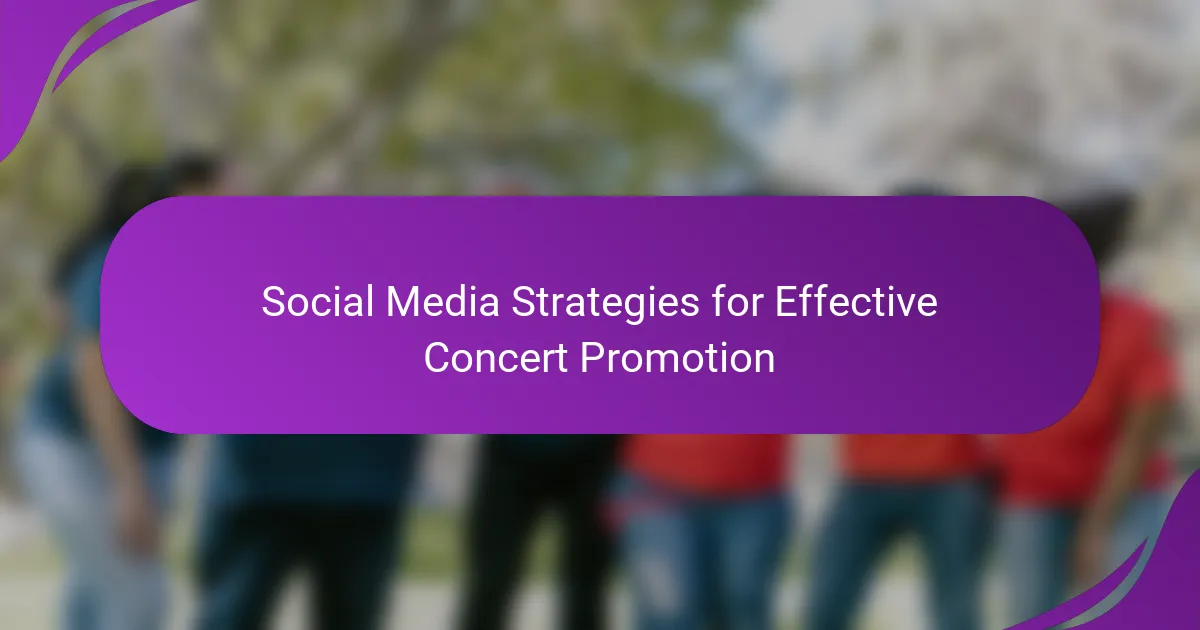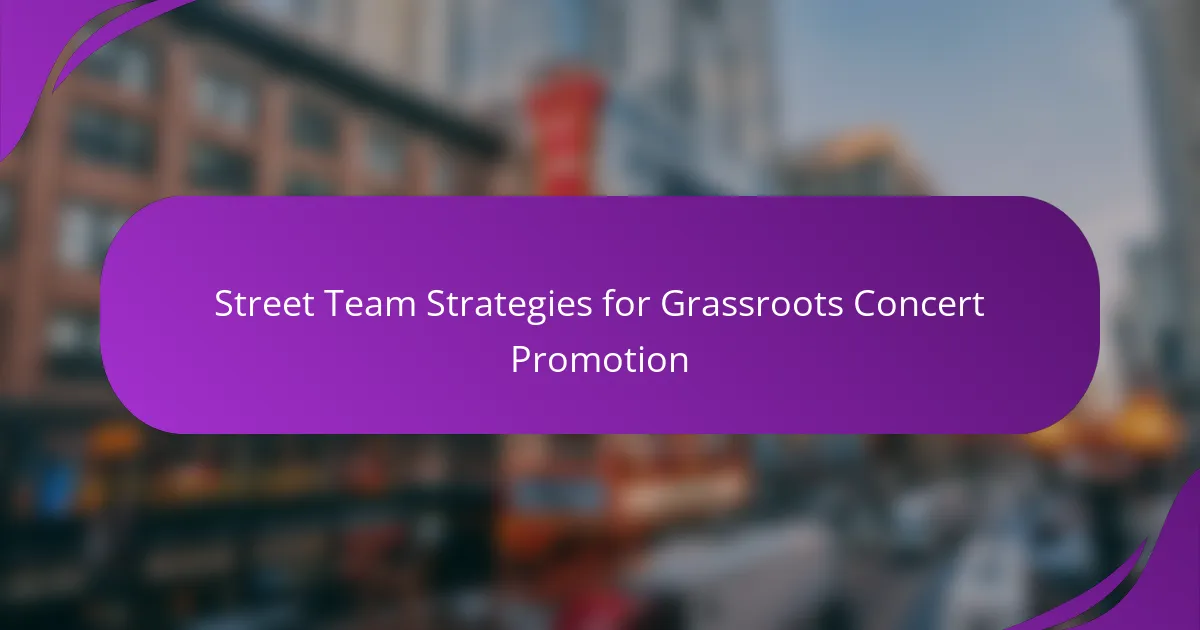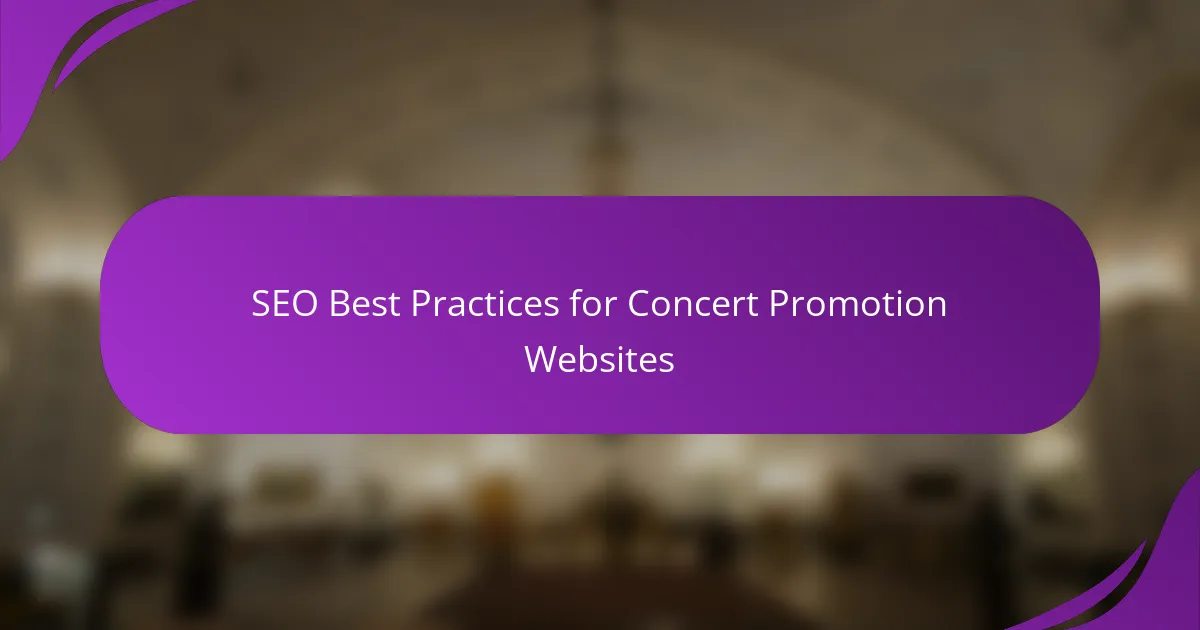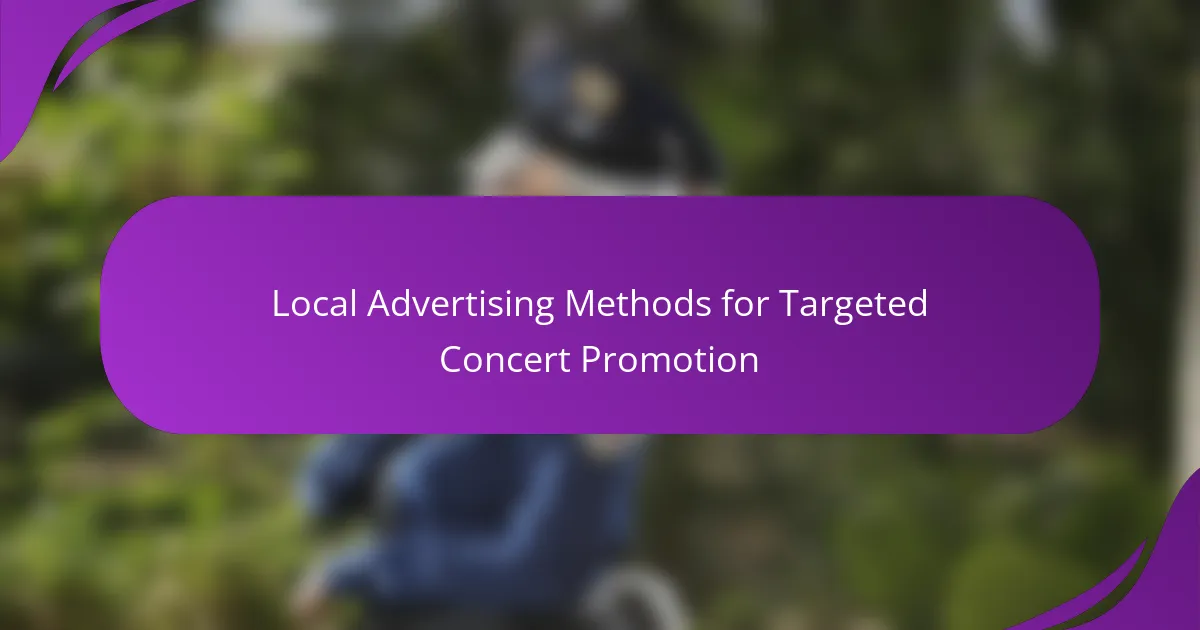A press release is a crucial tool for concert promotion, designed to generate interest and coverage for an event. Key elements include a compelling headline, essential event details, quotes from artists, and background information about the performers. Effective press releases also utilize targeted distribution channels and engaging visuals while optimizing content for search engines. Success can be measured through metrics such as media coverage, audience engagement, and ticket sales, with studies indicating a potential increase in ticket sales by up to 20% when executed properly. This article outlines the essential components and strategies for creating impactful press releases in the context of concert promotion.
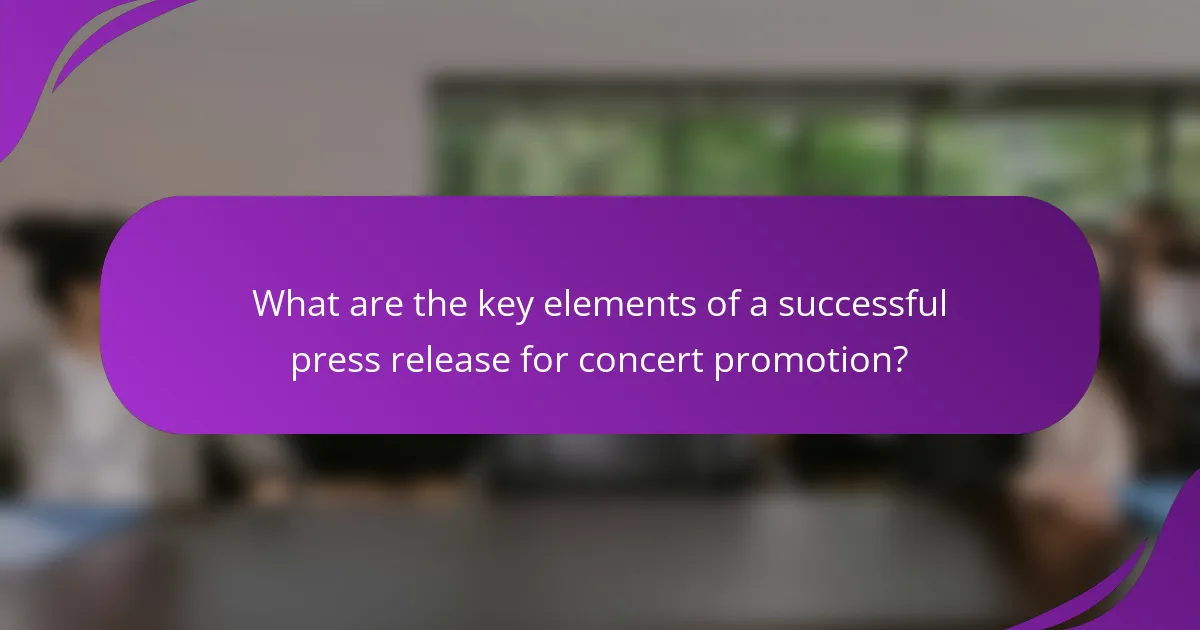
What are the key elements of a successful press release for concert promotion?
A successful press release for concert promotion includes several key elements. First, a compelling headline captures attention and summarizes the event. Next, a strong opening paragraph provides essential details such as the who, what, when, where, and why of the concert. Following this, quotes from the artist or organizer add a personal touch and credibility. Additionally, including background information about the artist or band enhances context and interest. A clear call to action directs readers on how to purchase tickets or find more information. Finally, contact information for press inquiries ensures media can reach out for further details. These elements collectively enhance the effectiveness of the press release in generating interest and coverage.
How does a well-crafted press release attract attention?
A well-crafted press release attracts attention through clear messaging and engaging content. It uses a compelling headline to draw in readers. The opening paragraph summarizes the key points effectively. This format allows journalists to quickly grasp the news. Including quotes from key stakeholders adds credibility and personalizes the message. Additionally, relevant statistics or facts can enhance the press release’s impact. Proper formatting and adherence to journalistic standards also improve readability. According to the Public Relations Society of America, effective press releases can increase media coverage significantly.
What are the essential components of a press release?
A press release consists of several essential components. These components include a headline, which captures attention and summarizes the main point. The subheadline provides additional context and detail. The dateline includes the release date and location, establishing timeliness and relevance. The introduction paragraph answers the who, what, when, where, and why of the announcement. The body elaborates on the details, providing supporting information and quotes from key stakeholders. A boilerplate section offers background on the issuing organization. Finally, contact information is provided for media inquiries. These components ensure clarity and effectiveness in communication.
How can the headline influence the effectiveness of a press release?
The headline significantly influences the effectiveness of a press release by capturing attention and conveying key information. A compelling headline can entice readers to engage with the content. Research shows that 80% of readers will only read the headline, making it crucial for initial impressions. Effective headlines often include strong action verbs and relevant keywords. This enhances search engine visibility and increases the likelihood of sharing. Additionally, headlines that convey urgency or exclusivity can prompt immediate action. Therefore, a well-crafted headline is essential for maximizing the reach and impact of a press release.
Why is timing important for press releases in concert promotion?
Timing is crucial for press releases in concert promotion because it directly influences audience engagement and ticket sales. Press releases should be issued at strategic moments to maximize visibility. For example, announcing a concert too early may lead to dwindling interest, while a last-minute release risks missing media coverage. Research shows that press releases sent out 2-3 weeks before an event garner the best response. This timeframe allows for adequate media coverage and audience anticipation. Additionally, aligning the release with other promotional activities can create a cohesive marketing strategy. Effective timing ensures that the press release reaches the target audience when they are most receptive.
What are the best times to distribute a press release?
The best times to distribute a press release are early in the week and during business hours. Specifically, Tuesday and Wednesday mornings are optimal. This timing allows journalists to receive the news before their deadlines. Many media outlets plan their content for the week on Mondays. Distributing on Tuesdays and Wednesdays ensures press releases are fresh and relevant. Research indicates that press releases sent during these times receive higher engagement rates. A study by Cision found that 65% of journalists prefer press releases during these mid-week days.
How does timing affect media coverage?
Timing significantly affects media coverage by determining when news is released and how it is perceived. Timely press releases can capture media attention during relevant events or trends. For example, releasing a concert announcement just before a major music festival can enhance visibility. Conversely, poorly timed releases may get overshadowed by other news. Research shows that 60% of journalists prefer news that aligns with current events. This alignment increases the likelihood of coverage and engagement. Thus, strategic timing is crucial for maximizing media impact.
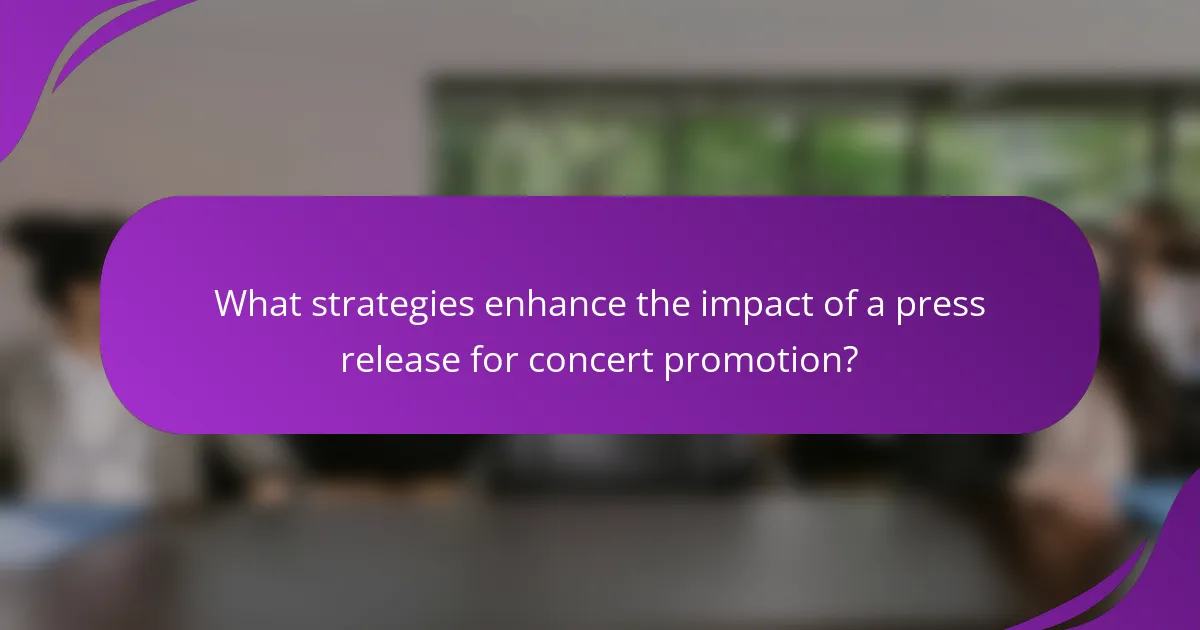
What strategies enhance the impact of a press release for concert promotion?
To enhance the impact of a press release for concert promotion, utilize targeted distribution channels. This ensures the release reaches the intended audience effectively. Incorporate a compelling headline to grab attention immediately. Use engaging visuals to complement the text and create a more appealing presentation. Include essential details such as date, location, and ticket information clearly. Utilize quotes from artists or organizers to add credibility and a personal touch. Optimize the content for search engines by using relevant keywords. Finally, follow up with media contacts to encourage coverage and increase visibility. These strategies collectively improve the chances of the press release being noticed and acted upon.
How can targeting the right audience improve press release effectiveness?
Targeting the right audience significantly enhances press release effectiveness. When a press release is directed toward the appropriate demographic, it increases the likelihood of engagement. This engagement can lead to higher media coverage and better audience reach. Studies show that targeted messaging can improve response rates by up to 50%. Additionally, understanding the audience’s interests allows for tailored content that resonates more deeply. This relevance fosters stronger connections and encourages sharing among peers. Ultimately, precise targeting maximizes the impact of the press release in achieving promotional goals.
What demographic factors should be considered when targeting an audience?
Key demographic factors to consider when targeting an audience include age, gender, income, education, and location. Age influences music preferences and concert attendance rates. Gender can affect marketing strategies and content focus. Income levels determine ticket pricing strategies and promotional offers. Education may relate to the audience’s engagement with music genres and events. Location is critical for venue selection and regional marketing efforts. Understanding these factors helps tailor marketing messages effectively.
How can audience segmentation enhance messaging?
Audience segmentation enhances messaging by tailoring communication to specific groups. This approach allows marketers to address the unique needs and preferences of each segment. For instance, younger audiences may respond better to social media promotions, while older demographics might prefer email updates. Research shows that personalized messages can increase engagement by up to 50%. By understanding audience characteristics, promoters can craft targeted press releases that resonate more effectively. This strategy not only improves message relevance but also boosts overall response rates.
What role do multimedia elements play in press releases?
Multimedia elements enhance press releases by increasing engagement and improving information retention. They can include images, videos, infographics, and audio clips. These elements capture attention and convey messages more effectively than text alone. Research shows that press releases with multimedia can generate up to 9 times more engagement. This increased engagement can lead to higher media coverage and audience reach. Additionally, multimedia can provide visual context, making complex information easier to understand. Overall, incorporating multimedia elements in press releases is crucial for maximizing impact and effectiveness.
How can images and videos elevate a press release?
Images and videos can significantly elevate a press release by enhancing visual appeal and engagement. Visual content captures attention more effectively than text alone. According to research by HubSpot, articles with images receive 94% more views than those without. Videos can convey messages quickly and clearly, making complex information more digestible. Additionally, press releases that include multimedia can increase sharing on social media platforms. This leads to greater visibility and reach for the announcement. Overall, integrating images and videos makes press releases more compelling and informative.
What types of multimedia should be included for maximum impact?
High-quality images, videos, and audio clips should be included for maximum impact in concert promotion press releases. Images of the artists and event venue enhance visual appeal. Videos can showcase past performances or artist interviews, engaging potential attendees. Audio clips of the music can provide a preview of the concert experience. Infographics can summarize event details effectively. Social media links can encourage sharing and increase reach. Together, these multimedia elements create a dynamic press release that captures attention and drives interest.
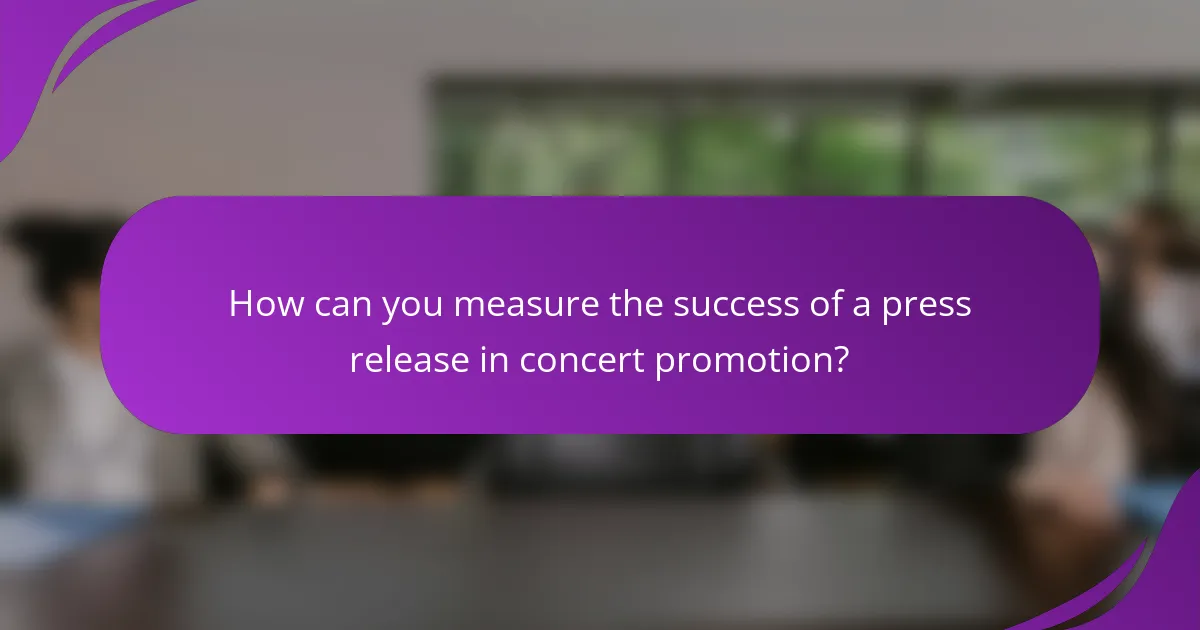
How can you measure the success of a press release in concert promotion?
Success of a press release in concert promotion can be measured through various metrics. Key indicators include media coverage, audience engagement, and ticket sales. Media coverage can be tracked by the number of articles published and their reach. Audience engagement is assessed through social media shares, comments, and likes. Ticket sales provide a direct measure of interest generated by the press release. According to a study by PR Newswire, press releases can increase ticket sales by up to 20% when effectively distributed. Additionally, monitoring website traffic and search engine rankings post-release can provide insights into increased visibility and interest.
What metrics are essential for evaluating press release performance?
Essential metrics for evaluating press release performance include reach, engagement, and conversion rates. Reach measures the total audience exposed to the press release. Engagement tracks interactions such as shares, comments, and likes. Conversion rates indicate how many readers took a desired action, like purchasing tickets. Additional metrics include media pickups, which show how many outlets covered the press release. Tracking these metrics helps assess the effectiveness of the press release in achieving its promotional goals. Studies indicate that releases with higher engagement rates lead to increased ticket sales, emphasizing the importance of these metrics.
How can media coverage be quantified and analyzed?
Media coverage can be quantified and analyzed using metrics such as reach, impressions, and sentiment analysis. Reach refers to the number of unique individuals exposed to the media coverage. Impressions indicate the total number of times the coverage is viewed, regardless of unique individuals. Sentiment analysis evaluates the tone of the coverage, determining if it is positive, negative, or neutral.
Tools like media monitoring software can automate the collection of these metrics. For example, platforms like Cision and Meltwater provide comprehensive reports on media mentions and audience engagement. Analyzing the data helps identify trends and the effectiveness of press releases.
Studies show that effective media coverage can increase event attendance by up to 30%. This demonstrates the importance of quantifying and analyzing media coverage for concert promotion success.
What tools can help in tracking press release effectiveness?
Tools that can help in tracking press release effectiveness include media monitoring services, analytics platforms, and social media tracking tools. Media monitoring services like Cision and Meltwater track press coverage and mentions across various outlets. Analytics platforms such as Google Analytics measure website traffic and user engagement from press release links. Social media tracking tools like Hootsuite and Sprout Social analyze shares, comments, and overall engagement on social media platforms. These tools provide data on reach, impressions, and audience sentiment, allowing for comprehensive evaluation of press release impact.
What are the best practices for writing a press release for concert promotion?
The best practices for writing a press release for concert promotion include crafting a compelling headline. A strong headline grabs attention and summarizes the event. Next, include essential details in the first paragraph. This should cover the who, what, when, where, and why of the concert. Use quotes from key figures, such as the artist or promoter, to add authenticity.
Incorporate relevant multimedia elements, such as images or videos, to enhance engagement. Ensure the press release is clear and concise, ideally one page long. Distribute the press release to targeted media outlets and online platforms to maximize reach. Finally, include contact information for follow-up inquiries. These practices ensure effective communication and increase the likelihood of media coverage.
How can clarity and conciseness improve readability?
Clarity and conciseness enhance readability by making information easier to understand. Clear language allows readers to grasp the main points quickly. Concise writing eliminates unnecessary words, reducing cognitive load. This combination helps retain the reader’s attention. Research shows that concise text can improve comprehension by up to 50%. In press releases, clarity and conciseness ensure key messages are communicated effectively, which is crucial for concert promotion success.
What common mistakes should be avoided in press release writing?
Common mistakes in press release writing include excessive jargon, lack of newsworthiness, and poor formatting. Using jargon alienates readers and makes the content less accessible. A press release must contain timely and relevant information to be considered newsworthy. Failing to include a clear headline and subhead can lead to confusion. Additionally, neglecting to provide contact information limits media follow-up opportunities. Overly promotional language can also detract from the credibility of the release. Lastly, not adhering to a standard length of one page can result in important details being overlooked. These mistakes can hinder the effectiveness of a press release in reaching its intended audience.
The main entity of this article is the press release, specifically in the context of concert promotion. It outlines essential elements for crafting a successful press release, including the importance of a compelling headline, clear messaging, and strategic timing for distribution. The article also emphasizes the role of targeted audience engagement, multimedia elements, and metrics for measuring effectiveness. Additionally, it provides best practices to enhance readability and common mistakes to avoid, ensuring that press releases effectively generate interest and media coverage for concert events.
